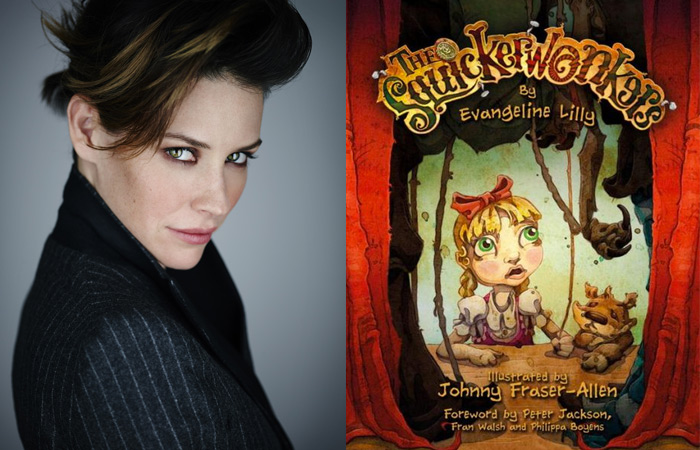Evangeline Lilly’s The Squickerwonkers Is a Creepy, Crawly Delight
 You may know her from her roles as Kate Austen in Lost or the elf Tauriel in Peter Jackson’s The Hobbit trilogy, but Evangeline Lilly is now adding “author” to her résumé. With the release of The Squickerwonkers, a rhyming and creepily cool picture book, Lilly makes the leap into children’s literature with a story that’s a little bit Grimm and a little bit Gaiman and a whole lot of imagination. In it, we meet Selma the Spoiled, who, like many a precocious tot left wandering alone, happens upon a mysterious wagon and an adorable, enabling rodent. But the show really begins when the fabulous, flawed Squickerwonkers—bizarro (and kind of alive) marionettes—take the stage.
You may know her from her roles as Kate Austen in Lost or the elf Tauriel in Peter Jackson’s The Hobbit trilogy, but Evangeline Lilly is now adding “author” to her résumé. With the release of The Squickerwonkers, a rhyming and creepily cool picture book, Lilly makes the leap into children’s literature with a story that’s a little bit Grimm and a little bit Gaiman and a whole lot of imagination. In it, we meet Selma the Spoiled, who, like many a precocious tot left wandering alone, happens upon a mysterious wagon and an adorable, enabling rodent. But the show really begins when the fabulous, flawed Squickerwonkers—bizarro (and kind of alive) marionettes—take the stage.
Each of them has…issues. To give you an idea of what to expect from this parade of nutty puppets, I give you a few of their names: Mama the Mean, Gillis the Gluttonous, Lorna the Lazy, and, my personal favorite, Meghan the Mute, an infant with a Napoleon complex. The illustrations of Johnny Fraser-Allen bring each and every one to devilish life, with an aesthetic that makes them look not unlike a villainous branch of the Potato Head family. These are some puppets you wouldn’t want to meet in a dark alley.
Lo, their wickedness knows no bounds, because just as Selma’s taking in the show, they up and pop her bright red balloon. She reacts predictably poorly (her name isn’t Selma the Sanctimonious after all), and then comes her comeuppance. This is a dark story with a morality element straight out of old-fashioned fables, and that was the intent. In discussing the book, Lilly laments that on the whole, we’ve abandoned the tradition of teaching children through stories. She uses Selma and the Squickerwonkers as an illustration of how kids themselves might feel and behave: they’re just like us, because we’re all a little good and a little bad.
While she acknowledges that many parents and adults are unaccustomed to exposing children to dark stories, kids themselves find them fascinating, because those stories feel alive. It’s an attitude Selma shares when she first lays eyes on the disconcerting Squickerwonkers: “Though the girl was suspicious/Her fear was delicious.” The book’s subject matter and tone calls to mind the works of Edward Gorey (think The Gashlycrumb Tinies), whom Lilly lists as one of her favorite childhood authors. As for the story—and the delightfully tactile title—she cites a different influence from her teen years: “I woke up to how marvelous Dr. Seuss was.”
Just like Seuss’s high-flying rhyme, Lilly’s story relies on a trust of its audience. It subscribes to the school of thought that adults have a thing or two to learn from children, in the same vein as stellar kids’ books like Once Upon an Alphabet, by Oliver Jeffers, a sly and wry flight through the alphabet highly recommended by Lilly. As she says, The Squickerwonkers is a “playground drama” meets cautionary tale, all told with behaviors kids can relate to. And they’ll have plenty of chances to do so, too, with 17 more Squicker-books planned—in two different series, composed of nine books apiece. Parents and kids will find out just what happens to Selma in the second book, due out in 2015, and adult readers can look forward to a separate novel/graphic novel project that’s in the works.
The Squickerwonkers is a soon-to-be-series that’s a delight to read and to look at. And in the meantime, if you want to see more of Evangeline Lilly, check her out in that upcoming arthouse flick based on a little-known novel by some guy named Tolkien.
The Squickerwonkers is on sale today.